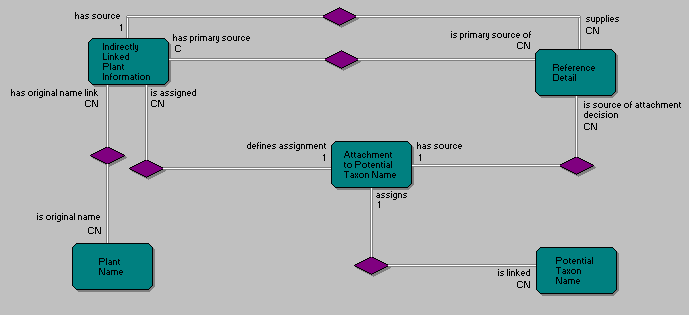
To understand the design decisions taken for this part model, the basic policy decisions taken by IOPI and CDEFD regarding its properties must be reviewed. These criteria generally apply to any model of a similar scope.
Basically, there are two possibilities how plant data can be incorporated into the database:
(a) Creation of a new potential taxon name. In this case, the potential taxon's circumscription reference represents both, the source of the linked data as well as the source of the attachment to this specific potential taxon name. This "directly linked information" (see diagram 1) has been restricted to status and classification information, i.e., the core taxonomic information, in order to avoid an inflation of potential taxa in the database.
(b) Attachment of the information to an existing potential taxon. In this case, the source of the data has to be cited separately from the person(s) or mechanism responsible for the decision to attach it to a specific potential taxon name. Moreover, in order to preserve the original information, an "original name link" (Bisby, 1994) must be stored as well.

Diagram 20: Attachment of information to taxa
The decision to restrict direct linkage to core taxonomic data is somewhat arbitrary. It is absolutely justified in the case of the huge body of plant information provided by non-botanists, which does not incorporate taxonomic judgment (e.g. much of the data on chemical composition or uses). However, a large amount of information is published in connection with taxonomic treatments, so that a certain duplication of referencing is caused (e.g. in geographic distribution statements made in floras). Nevertheless, although this may complicate data input procedures, it will not generate additional output. In contrast, generation of new potential taxa will do so.
A compromise may be struck by introducing an integrity rule, which makes it obligatory that the attachment source reference is the same as the potential taxon circumscription reference (for example, see the discussion of linkage of distribution data in the next chapter).
Within the framework of the CDEFD and PLANTAS III projects, work is under way to provide a detailed model for botanical collections, as well as models for karyological information and chemical data relating to secondary metabolites, the latter serving as examples for modeling experimental studies in general.
Next chapter; Contents of this article; Complete entity list; References cited; Author information. Last updated: June 23, 1995